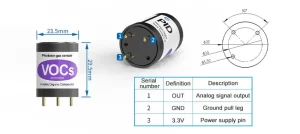Indoor air quality (IAQ) is a critical aspect of the health and safety of building occupants. Poor IAQ can lead to various health issues, such as respiratory problems, headaches, and allergies. Additionally, it can reduce productivity and increase absenteeism in schools and workplaces. Indoor air quality can be affected by various factors, including outdoor air quality, building design, and occupant behavior. In this article, we will explore how gas sensors can improve IAQ by monitoring the levels of pollutants and enabling effective ventilation strategies.

Understanding Indoor Air Pollution
Indoor air pollution refers to the presence of harmful gases, particulate matter, and microorganisms in the air inside buildings. These pollutants can come from various sources, such as combustion appliances, building materials, cleaning products, and human activities. Here are some common indoor pollutants:
a. Volatile Organic Compounds (VOCs):
VOCs are organic chemicals that vaporize at room temperature, emitting harmful gases into the air. They are present in cleaning products, paints, adhesives, and other household items. Exposure to high levels of VOCs can cause headaches, nausea, and eye irritation.
b. Carbon Monoxide (CO):
CO is a colorless, odorless gas produced by incomplete combustion of fuels such as wood, gas, and oil. High levels of CO can cause dizziness, nausea, and even death.
c. Particulate Matter (PM):
PM is a complex mixture of tiny particles suspended in the air, including dust, pollen, and smoke. Exposure to high levels of PM can cause respiratory problems, particularly in vulnerable populations such as children and the elderly.
d. Radon: Radon is a radioactive gas that occurs naturally in soil and rock. It can seep into buildings and accumulate to high concentrations, posing a risk of lung cancer.
The Role of Gas Sensors in Improving Indoor Air Quality
Gas sensors are critical tools for monitoring indoor air quality. They detect the presence and levels of various pollutants, enabling effective ventilation and air treatment strategies. Here are some ways gas sensors can improve IAQ:
a. VOC Monitoring: Gas sensors can measure the concentration of VOCs in indoor air, helping to identify sources of indoor air pollution. This information can guide the selection of low-emission products and the implementation of effective ventilation strategies.
b. Carbon Monoxide Detection: Carbon monoxide detectors are gas sensors that can detect and alert occupants to high levels of CO in indoor air. They help prevent exposure to this dangerous gas and improve occupant safety.
c. Particulate Matter Monitoring: Gas sensors can measure the levels of particulate matter in indoor air, providing insights into sources of indoor pollution such as smoking, cooking, and outdoor air pollution. This information can guide the implementation of effective filtration and ventilation strategies.
d. Radon Detection: Gas sensors can detect the levels of radon in indoor air, helping to identify areas with elevated concentrations. This information can guide the implementation of effective radon mitigation strategies, such as sealing cracks and installing ventilation systems.
Effective Ventilation Strategies
Ventilation is a critical aspect of improving IAQ. It involves the exchange of indoor and outdoor air, reducing the concentration of pollutants and increasing the supply of fresh air. Effective ventilation strategies depend on various factors, such as building design, occupant behavior, and outdoor air quality. Here are some key strategies:
a. Natural Ventilation: Natural ventilation involves the use of windows, doors, and vents to allow the flow of outdoor air into the building. It is an effective strategy in moderate climates and can reduce the need for mechanical ventilation systems.
b. Mechanical Ventilation: Mechanical ventilation involves the use of fans and ducts to circulate and filter indoor air. It is essential in buildings with poor natural ventilation and high occupant density, such as schools and offices. Mechanical ventilation systems can be designed to provide continuous or intermittent airflow, depending on building and occupant needs.

c. Air Filtration: Air filtration involves the use of filters to remove particulate matter and other pollutants from indoor air. It is particularly useful in buildings with high levels of outdoor air pollution or those located near major sources of pollution, such as highways.
d. Air Quality Monitoring: Regular monitoring of indoor air quality using gas sensors helps identify areas with high levels of pollutants and guides the implementation of effective ventilation and air treatment strategies. This approach ensures that ventilation systems are optimized for occupant health and comfort while minimizing energy consumption.
Future Directions
The use of gas sensors to improve IAQ is a rapidly evolving field. Here are some future directions:
a. Integration with Building Aut
 : +86 155 8830 2704
: +86 155 8830 2704 : jxdziot@gmail.com
: jxdziot@gmail.com
